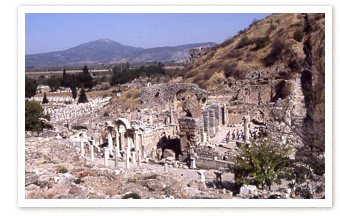

3. A history of Ephesus from coins: the Greek state
3.4 Alexander and his successors at Ephesus
Alexander the Great ( link ) became king of Macedon in 336, and almost immediately set out to conquer the Persian Empire. He took Ephesus without a fight. Alexander did not put his portrait directly on the coins he issued, but the young Herakles that does appear on the obverse of his silver coins certainly has features that resemble other portraits of Alexander. He had good relations with Ephesus, and offered to rebuild the Temple of Artemis, which had burnt down on the day of his birth; he was politely refused.

The Commercial Agora ( tetragonos agora ) of the
city
built by Lysimachus.
During this period Ephesus issued an important series of Rhodian standard tetradrachms in the years between c.405 - 325BCE. The names of the magistrates responsible for the coinage were presented on the reverse ( 11 , 19 ).
Between 319 and 302 BCE Ephesus was ruled by Antigonos Monophthalmos and his son Demetrios Poliorketes. They probably minted at Ephesus, according to E. T. Newell, though neither the name of the city nor its symbol appear on their coins.
In 295 BC Ephesus was finally captured by Lysimachos, a former bodyguard of Alexander the Great, who defeated Antigonus at the Battle of Ipsus. Lysimachos didn't put his own portrait on his coins, however, but that of Alexander ( 42 ). Lysimachos re-founded Ephesus, and renamed it in honor of his second wife Arsinoe ( 20 ); when the Ephesians wouldn't move from around the Temple of Artemis back to Mt. Pion, he stopped up the waterways until they had to move to avoid the floods. Lysimachos also killed his heir, son of his previous wife, apparently for the benefit of Arsinoe. This prompted his former ally Seleucus I to invade, and Lysimachos was killed in 281.
After Lysimachos' death, Ephesus fell into the hands of varying Seleucid and Ptolemaic rulers. In 202 BC it was captured by Antiochus the Great. On his defeated in 190 BC at the battle of Magnesia, the Romans presented Ephesus to Eumenes, the king of Pergamon. During the second century BC Ephesus minted a long series of Attic standard drachms, with the magistrates name on the reverse ( 12 ).
The Attalid rulers initiated an important new coinage around 166 BCE– the cistophoroi (named from the cista mystica – the sacred chest from the cult of Dionysos which was shown on the coins). Ephesus began minting cistophoroi around 138 BCE ( 21 ).
The last Attalid, Attalus III, willed his kingdom to Rome in 133 BCE, and from that point on Ephesus became part of the Roman province of Asia.





